Dancing with Robots
Ingenuity and creativity highlight a contest in which student-built robots play soccer, dance, or go on a rescue mission.
By Sarah Webb
Sprague’s Sprockets, a team of two boys and two girls, waited nervously for its turn at the search-and-rescue station as the RoboCup Junior competition got under way.
The students from Adelphi Academy in Brooklyn, N.Y., had checked the settings on their robot’s infrared sensors. They’d tweaked their computer program and loaded it into the robot. Soon, they would send the robot along a path with turns, obstacles, and even a ramp.
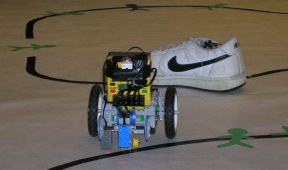 |
|
The robot built by the Sprague’s Sprockets team pauses on the search-and-rescue course at the RoboCup Junior competition. |
| Sarah Webb |
But team programmer Monica Furman, 11, seemed concerned. When I asked her whether the team was ready, she answered, “No.” When I asked her what she was worried about, she said, “Everything.” As it turned out, she was right.
When the team released its robot at the starting line, it stalled. Although the sensors and wheels appeared to be working, the robot wouldn’t move along the path marked on the course in front of it.
The judges gave the Sprockets a few more chances. Nothing worked. It was back to the drawing board. “The program itself is so complicated,” Furman said. “The robot got confused.”
Computer brain
At RoboCup Junior, an all-day event held in late March at the City University of New York (CUNY) Graduate Center in Manhattan, Sprague’s Sprockets and the other teams worked through the challenges that all robot designers face.
The young engineers on each team needed to build a strong, reliable, mobile robot. And they had to give the robot’s computer brain the information it would need to make good decisions about when to turn, when to stop, and how to move around an obstacle.
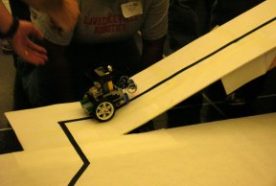 |
|
A robot attempts to climb a steep ramp, part of the search-and-rescue course. |
| Sarah Webb |
RoboCup Junior is a competitive event that allows students from elementary schools and high schools to test their robotics skills in one of three tasks. In addition to navigating a search-and-rescue course, competing robots can play soccer or take part in a dance contest.
“All the robots in RoboCup Junior are completely autonomous, which means that there are no remote controls,” says Elizabeth Sklar. A professor of computer science at Brooklyn College, she organized the New York event.
“The kids write the program on their computer, they download it to the robot, and then it’s hands off,” she says.
Search and rescue
After their first attempt at the search-and-rescue course, Sprague’s Sprockets took its robot to a nearby room filled with long tables. There, teams of kids adjusted wheels and motors and calibrated sensors. They checked computer programs. They made sure that their robots had plenty of battery power.
Like many other teams at RoboCup Junior, the Sprockets had split the tasks associated with building their robot. Two team members were responsible for building the robot and the other two were in charge of programming it. To prepare for a second try at the rescue mission, Furman and Anthony Talpak, 12, focused on fixing the computer program. Builders Alex Gadas, 10, and Nadia Makos, 12, put in a faster motor.
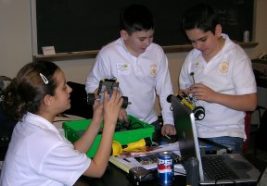 |
|
Nadia Makos (left), Alex Gadas (middle), and Anthony Talpak (right) of Sprague’s Sprockets work on their search-and-rescue robot. |
| Sarah Webb |
On its second run, the team’s robot started up perfectly. It navigated a sharp left turn. It stopped, as it was supposed to, when it reached a little figure representing a person. But farther along on the course, the robot kept hooking left. And when it tried to mount the ramp, its wheels didn’t have enough traction to make the climb.
In the end, the course proved too challenging for all but a few high school teams. But Sprague’s Sprockets had been working on its robot for only about 2 months. The four team members learned a lot just from being in the competition.
Soccer mania
While some robots were navigating the rescue course, others were competing in soccer matches.
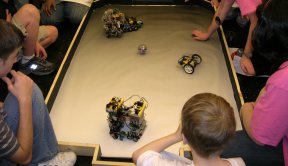 |
|
Two teams of two robots face off in a soccer game. |
| Sarah Webb |
Each “team” in robot soccer has two players: a striker and a goalie. Designing these two robots presents special challenges for designers. The robots need to respond to one another and to the ball. They need to know which way to move, where to kick, and how to defend.
Many teams built their soccer robots from Lego-based kits that provide parts, motors, a special programmable brick, and programming software. But RoboCup Junior doesn’t require students to use any particular materials.
“That’s one wicked-looking robot,” said one kid as he walked by where 16-year-old Nick Oren and Joel Holmes, from Danville, Penn., were adjusting their robot. Their striker looked like a three-tiered Plexiglas cake loaded with circuitry. Oren had spent 50 hours over more than 4 months building it.
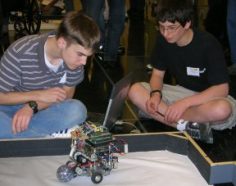 |
|
Joel Holmes (left) and Nick Oren with their striker soccer robot. |
| Sarah Webb |
In robot soccer, the ball emits infrared radiation. The robot uses its sensors to find the ball. How a robot kicks the ball, however, is entirely up to the designer. Oren’s robot used puffs of compressed gas, which sent the ball flying across the field.
The team’s goalie whipped balls out of the way with a giant spinning paddle mounted between two towers of wires and circuits. The goalie was easier to build than the striker, Oren noted. It took him just “a snow day and a half” to complete the robot.
Programming the robots was also a challenge. Holmes, the team programmer, continued to adjust the computer commands throughout the competition to improve the robots’ ability to respond.
The games were exciting, with teams cheering on their robots, lots of fast scoring, and plenty of crashes. In fact, some games were more like demolition derbies—with wheels and other parts flying off. Teams often accepted a 1-minute penalty to do a quick fix.
Robot boogie
Robot dance involves simpler robot programming and design than the other two tasks at RoboCup Junior. But it allows for a wide variety of creativity.
Several teams programmed robots to dance to either techno music or hip-hop. A team called the RoboRockets danced a jungle boogie along with its robot. A robot geisha built by Alex Doreda and Monica Zhou, both 16, performed an elegant dance perfectly timed to a beautiful Asian melody.
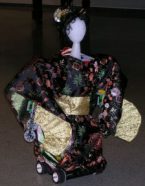 |
|
Alex Doreda and Monica Zhou built this dancing geisha robot. |
| Sarah Webb |
Doreda and Zhou, who are from Lawrenceville, N.J., spent about a month building the Lego body of their robot. They added the kimono on the day of the competition, making final adjustments to their robot’s computer program to accommodate the costume.
The judges were impressed by the creativity and teamwork among the dance entries, said Adrienne Klein. She served as one of the judges and is a codirector of the Science & the Arts program at CUNY.
“When we interviewed the teams, we discovered that they had been ambitious with their programming and really taken risks,” Klein said. “And the risk taking is what we really wanted to reward here.”
Nothing ran perfectly smoothly for the young robot builders and programmers competing in RoboCup Junior. But there were many moments of triumph as the teams worked to make their robots do what they were supposed to do.
Going Deeper:
News Detective: Building Robots







